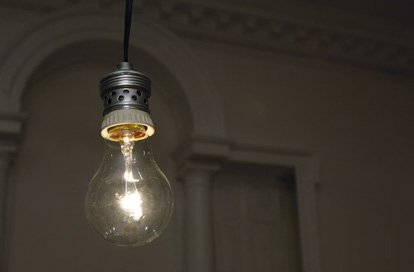Twilight from Jorge Macchi on Vimeo.
Twilight
Performance and sound installation. Metal wire, bulb, engine. Glass harmonica and MAX/MSP patch.
Music composed by Edgardo Rudnitzky.
Glass harmonica player: Alasdair Malloy.
Engineer: Guillermo Ramis
Duration: 20 minutes.
Variable dimensions.
Firstsite, Colchester
(Fragment of a letter by Jorge Macchi sent to Dawn Ades, curator of the project Light music.) :
"As you will see this work has evolved a lot and maybe the idea of fading out is not the main issue. It is a quite old idea I had from my stay in Rotterdam: a bulb crossing a room and dimming at the same time a musical piece is listened, the black out coinciding with the end of the piece. Some time ago we started thinking about this piece with Edgardo and we decided to have two musicians on both extremes of the course of the bulb, the music passing from one angle to the other as the bulb dimmed. We never developed the idea until your proposal. Here in Buenos Aires I started working with an engineer for solving the mechanism to move and dim the bulb. He found a marvelous and poetic solution: the bulb would slide along two metal wires that would also give the energy to it. But the metal wires are made in a material that has a specific resistance so as to hinder the conduction of electricity gradually along the distance. This resistance can be calculated to arrive to a black out in a precise distance. In this way the metal wires support and feed the bulb, but at the same time they kill it gradually. In a way they erase it gradually. The speed of the bulb can be graduated by a simple engine. At the same time Edgardo decided that the piece needed a glass instrument: the glass harmonica. Here in Buenos Aires we discussed a lot with Edgardo about the musical piece. There was something annoying about the two musicians, something that didn’t match completely with the movement and dimming of the bulb. The sound passed from one angle to the other but the piece didn’t evolve. In this point we found a solution. It is quite difficult to explain but I will try. Imagine the glass harmonica has 36 notes. In the beginning of the performance the musician plays all the notes following Edgardo’s score. In one moment the musician doesn’t play anymore one note, for example C. In this moment the resonance of the note C starts to be listened from the other angle of the room where there is a speaker. In the middle of the performance the musician plays just with the half of the notes of the instrument, and from the other angle we can listen to an overlay of all the sustained sounds that the musician doesn’t play anymore. In the end of the piece the musician plays just one note and from the other angle the overlay of all the notes can be heard. Music evolves to noise at the same time light evolves to darkness; the things we can clearly perceive in the beginning are blurred and disappear in the end of the piece. There are some things that are present in both works. Maybe we have to think about them in order to find an overarching concept or title for both pieces. Glass is the material of the two pieces: the four layers of glass in the song, the instrument and the lamp in the other piece. The glass produces the sound on both works. The way the light passes through the glasses and casts on the sanded stripes in The singers’ room has a resemblance with the process of electronic filtering of the sounds in Twilight. The appearance and erasure of the letters and the theme of the poem in Song… is related to the erasure of the music and the image in Twilight."
